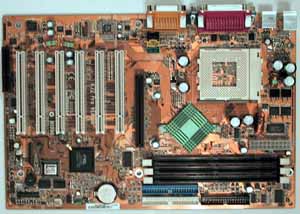MSI K7T Pro
|
Motherboard Specifications |
|
| CPU Interface |
Socket-A
|
| Chipset |
VIA KT133
VIA 8363 North Bridge VIA 686A South Bridge |
| L2 Cache |
N/A (on-chip)
|
| Form Factor |
ATX
|
| Bus Speeds |
100
/ 101 / 103 / 105 / 107 / 109 / 110 / 111
113 / 115 / 117 / 120 / 125 / 130 / 133 / 135 137 / 139 / 140 / 143 / 145 / 148 / 150 / 155 / 167 |
| Voltages Supported |
Auto Detect
Adjustable from 1.6V - 1.8V |
| Memory Slots |
3 168-pin DIMM Slots
|
| Expansion Slots |
1 AGP Slot
6 PCI Slots 0 ISA Slots 1 CNR Slot (shared) |
| AC'97 |
Analog Devices AD1881
|
| BIOS |
Award 6.00PG
|
The MSI K7T Pro was by far most feature packed of the early boards we received. It had by far the most FSB speeds, including 100 / 101 / 103 / 105 / 107 / 109 / 110 / 111/ 113 / 115 / 117 / 120 / 125 / 130 / 133 / 135 / 137 / 139 / 140 / 143 / 145 / 148 / 150 / 155 / 167. However, we must point out once again that our early overclocking experiments with the KT133 chipset have only been able to hit FSB speeds of 105 MHz. On the more mature Slot-A platforms, we were able to get in the vicinity of 110 MHz. The available FSB speeds and the stability of those settings could easily change for the final board.

Core voltage adjustment from 1.6-1.8V was also available for pushing that overclocked CPU to its maximum speed. Four monster 4700 uF and three equally sized 3900uF capacitors make sure that the CPU gets enough power.
A total of 3 DIMM slots, 6 PCI slots, and a shared CNR slot cover the expansion possibilities. Like the K7 Pro, the K7T Pro features a PCI arbiter chip that allows all 6 of those PCI slots to host bus mastering cards. The inclusion of the CNR slot is a bit unique since the VIA 686A Super South Bridge was designed with AMR in mind only. We'll have to wait and see how MSI plans to handle CNR cards. We are happy to see the CNR slot become a shared one, rather than take up precious PCB space that could be allocated to a PCI slot. We expect to see this trend become more and more common on future motherboards.











0 Comments
View All Comments